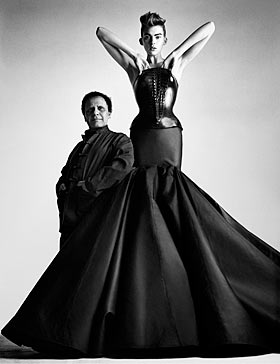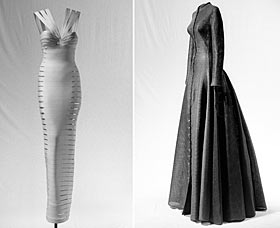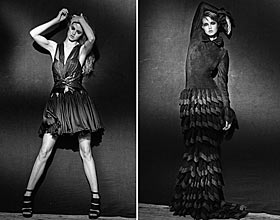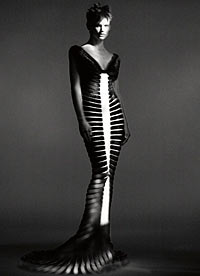Azzedine Alaïa: the king of couture

Simply sign up to the Life & Arts myFT Digest -- delivered directly to your inbox.
For more than a year and a half, Azzedine Alaïa, myself and the museum have worked together to make this exhibition not only a retrospective of this unique designer’s work but also a celebration of the reopening this autumn of the Palais Galliera, which has been closed for renovation since 2009.
Originally, the Duchess of Galliera, who donated the museum to the city of Paris in 1895, wanted to dedicate her museum to sculpture. And today the Galliera is exhibiting sculptures, though of a different kind, ones in fabric, cut on the round, in silk chiffon; statues of jersey and zippers; each outfit emphasising the fact that fashion created by the great designers is not ephemeral.
For the exhibition, designed by Martin Szekely, some 80 Alaïa pieces, presented like sculptures, wind their way through the newly revamped museum. Visitors will walk through a gallery space with Pompeiian red walls, painted ceilings, subtle mosaics and black woodwork that mirrors the original decor of the museum when it first opened in the 19th century.
There are no hard-edged showcases in this setting. The Alaïa pieces, which are grouped together according to the major themes of his work, make a strong impact against the vast space, clean lines and emptiness of the location. Each masterpiece from the couturier reflects his obsession with defining womanly curves.
Alaïa shares the focus and skills of such earlier couturiers as Madeleine Vionnet, Cristóbal Balenciaga and Madame Grès, designers who found themselves singled out for their high fashion ideals. They had outstanding expertise and were the architects of clothes that will last over time.

Alaïa, who was born in 1939 in Tunis, Tunisia, studied at the École de Beaux Arts there, paying his way through college by working on small couture projects that rapidly spread his reputation throughout the city. Although he spent a short time at Christian Dior and Guy Laroche when he arrived in Paris in the late 1950s, Alaïa gained more valuable experience from working with his own clients, women who acclaimed him as the designer of their dreams because his clothes were neither fussy nor affected. The Countess of Blégiers, Simone Zerfhüss, Louise de Vilmorin, Arletty and the divine Greta Garbo were among some of his most faithful and refined clients. Later, women such as Tina Turner, Grace Jones, Naomi Campbell and Rihanna joined their ranks. He himself says that it’s the women who make fashion and the designers who create the clothes.

Encouraged by his fellow designer Thierry Mugler, Alaïa presented his first collections in the late 1970s. His perforated leather with a devilishly sensual cut; dresses in knitted jersey, embossed with zippers; and chiffon gowns cut to perfection have proven to be timeless.
The dresses he shapes and sculpts, with their strong relationship to the body, have in the opinion of many costume historians changed notions of femininity to such a point that Alaïa can be considered the source of some of the 1980s main fashion changes; he broke away from all the preconceived ideas of the previous decades – the soft shapes and full skirts – to create a new body-conscious silhouette.

In his workshop in the Marais, he gave birth to some of the most beautiful work of the second half of the 20th century. A dress made of strips of fabric or carved bands, a piece worn by Grace Jones, and a powder-puff dress are among the exceptional pieces in the collection and on show. With their curious perfection that falls somewhere between austerity and sensuality, his coats, jackets and redingotes reflect the inspiration he draws from ancient Amazons.
Alaïa is not influenced by mere fashion: year after year, season after season, he brings his own ideas to maturity. Yet fashion is highly influenced by him: many of his key signatures such as body-conscious dressing, godet inserts and his use of leopard print are now widely referenced motifs. With his exacting standards and team of petit mains, Alaïa has presented collections that show an intuitive understanding of haute couture, even if his clothes can be bought as ready-to-wear.
With the force of his own will power, and following his own rhythm with total independence, Alaïa produces collections that follow each other like chapters of a book. He goes beyond fashion; he creates works of art.
——————————————-
‘Alaïa’, Palais Galliera, 10 Avenue Pierre ler de Serbie, 75116 Paris, September 28 2013 to January 26 2014, www.galliera.paris.fr
Comments